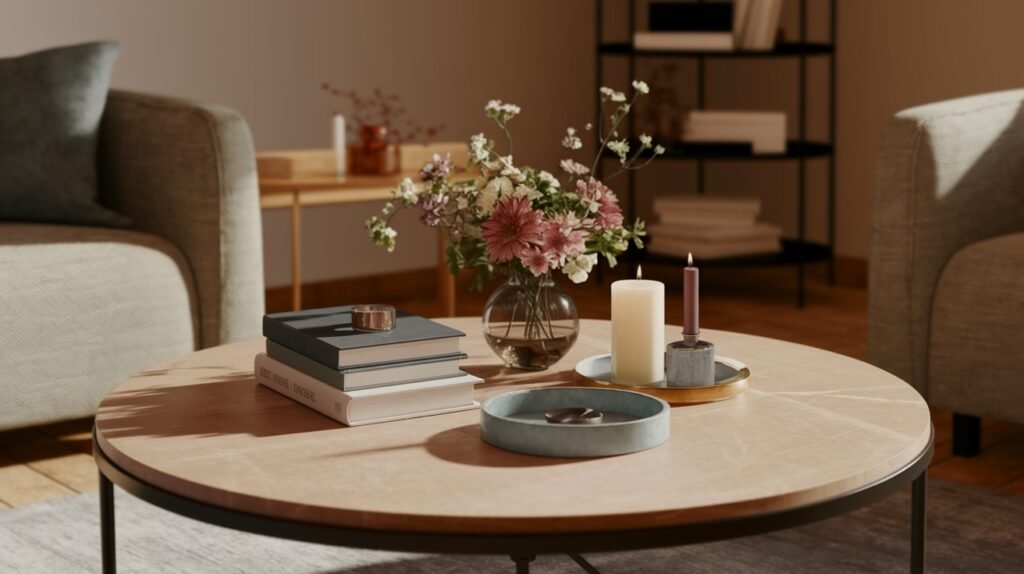Let’s be honest – round coffee tables can be tricky to style. You’ve probably stared at yours, wondering how to make it look put-together instead of cluttered. Maybe you’ve tried copying magazine photos only to have everything look awkward and forced.
Here’s the thing: round tables need different rules from rectangular ones. What works for your dining table won’t work here.
I’ve spent years figuring out what works (and what doesn’t). This guide shares the real techniques designers use – not complicated theories, but practical methods you can use today.
You’ll learn the triangle method that makes any arrangement look balanced. We’ll cover how to create height without blocking conversations. I’ll show you which items to use and which to skip. Plus, you’ll see how to keep your table both beautiful and functional.
No more guessing or copying random Pinterest boards. These are proven strategies that work for any style, any budget, and any living situation.
Ready to finally get this right?
Tips For Round Coffee Table Decor
Here are the tips for round coffee decor that you’re sure to love. Let’s get started:
The Triangle Layout Method – Your Foundation for Success
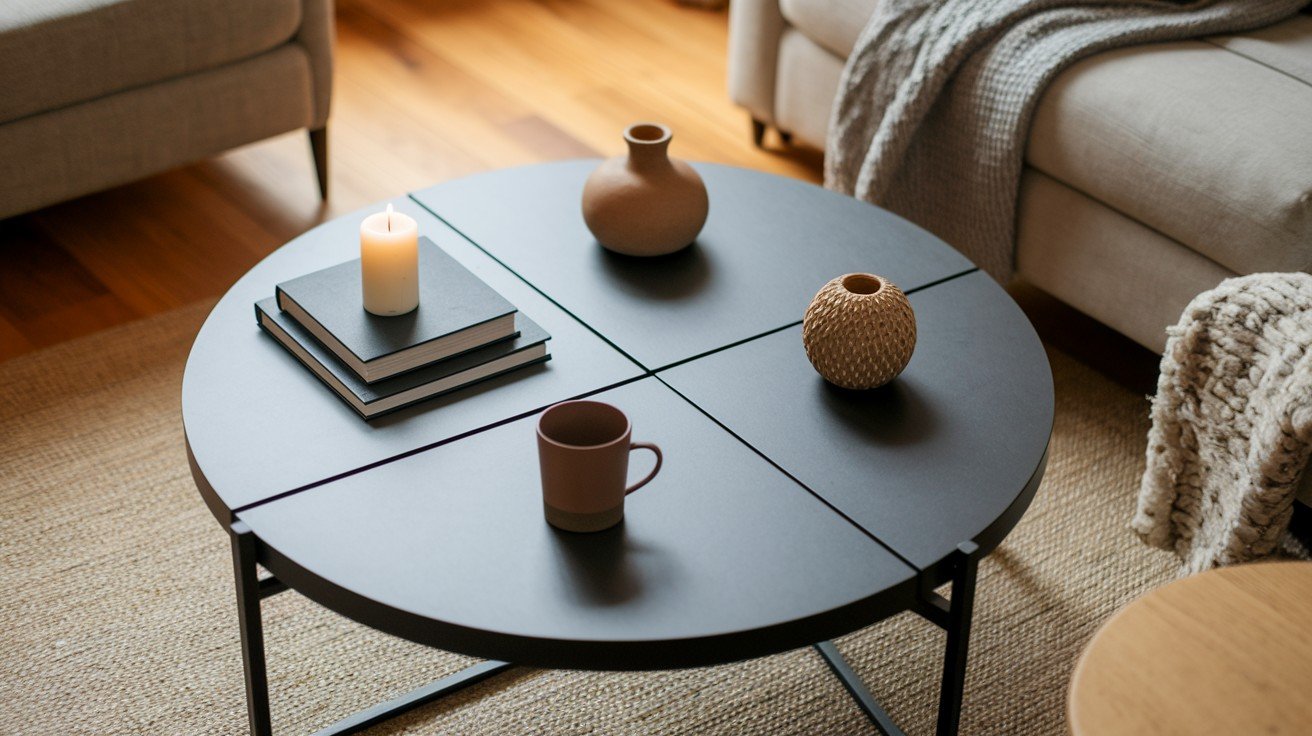
Here’s the secret: treat your round coffee table like it has invisible corners. This gives your circular surface structure and prevents random, cluttered arrangements.
Creating Three Visual Points
Picture your round coffee table as a triangle. This simple trick changes everything. Instead of randomly placing items around the edge, you’ll create three distinct spots. Think of them as the corners of an invisible triangle sitting on your table.
Here’s how it works: place one group at noon, another at 4 o’clock, and the third at 8 o’clock. This creates a natural balance that your eye loves. The “rule of threes” isn’t just design talk. Our brains prefer odd numbers. Three feels complete but not overwhelming.
Leave space between each group. You’re not filling every inch. You’re creating breathing room that makes each grouping stand out.
Practical Triangle Applications
Let me show you exactly what this looks like.
Group 1: Stack two books and place a small candle on top.
Group 2: Add a medium-sized decorative bowl or vase.
Group 3: Include a different textured item like a wooden sphere or ceramic figure.
See how each corner has something different? That’s the magic happening.
This method stops your table from looking like a garage sale. Everything has a purpose and place. Plus, you’ll still have room in the center for your coffee mug. Or a wine glass. I don’t judge.
Building Your Focal Point Strategy
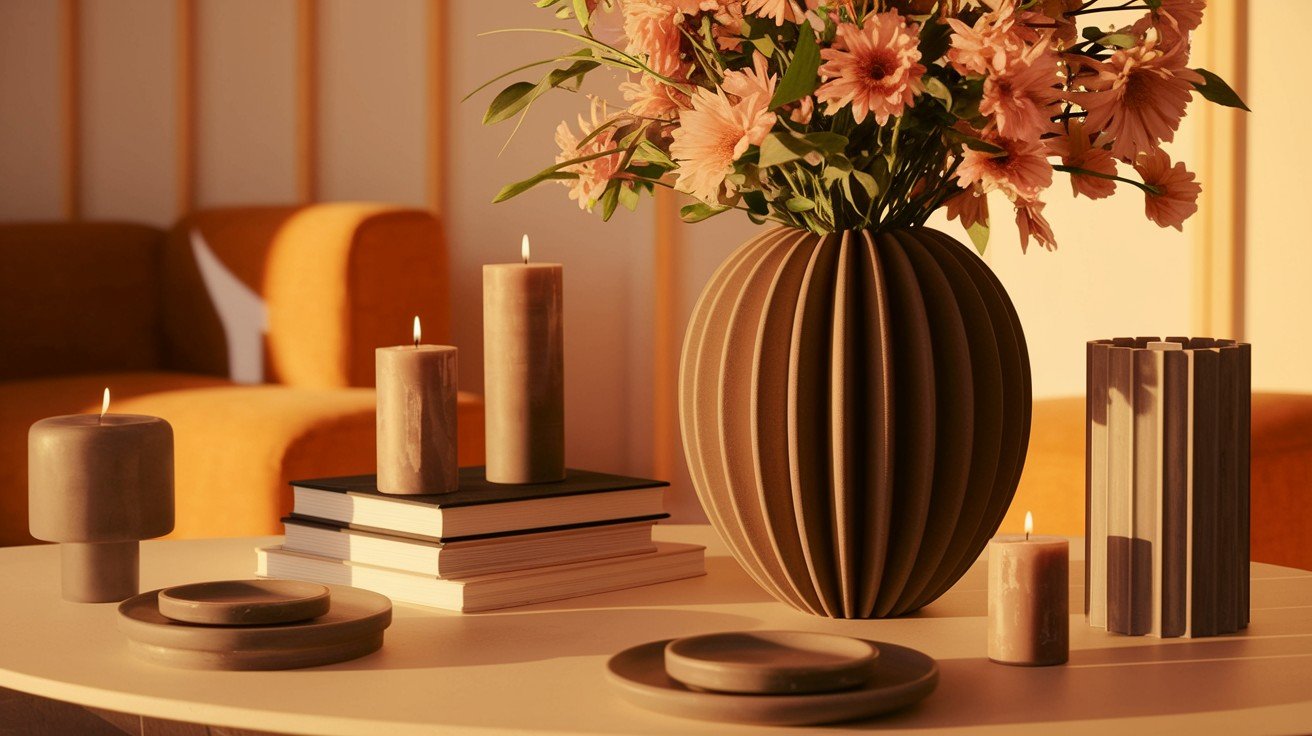
Once you have your triangle spots planned, you need a star player. This focal point becomes the visual anchor that makes everything else work together.
Selecting Anchor Pieces
Every great arrangement starts with one hero piece.
This is your anchor – the item that draws attention first. It should be your largest or most interesting object. Think vases, sculptural pieces, a beautiful plant, or fresh flowers. Size matters here. Your anchor piece should be proportional to your table. A tiny bud vase on a large round table looks lost. A massive centerpiece on a small table looks ridiculous.
Your focal point does the heavy lifting. It organizes everything else around it. Pick something you love, not just something that fills space.
Creating Dynamic Height Variation
Flat arrangements are boring arrangements. Period.
Stack books to create platforms for smaller objects. I love using coffee table books because they’re sturdy and look intentional. Add one tall element per arrangement. A slender vase with branches works perfectly. So does a tall candlestick or a small sculpture.
Mix your candle heights, too. Use pillar candles, votives, and tea lights together. The varying flames create a cozy, layered feeling. Why does this work? Your eye needs places to travel. Different heights give it a path to follow around your table.
Mastering Texture and Material Combinations
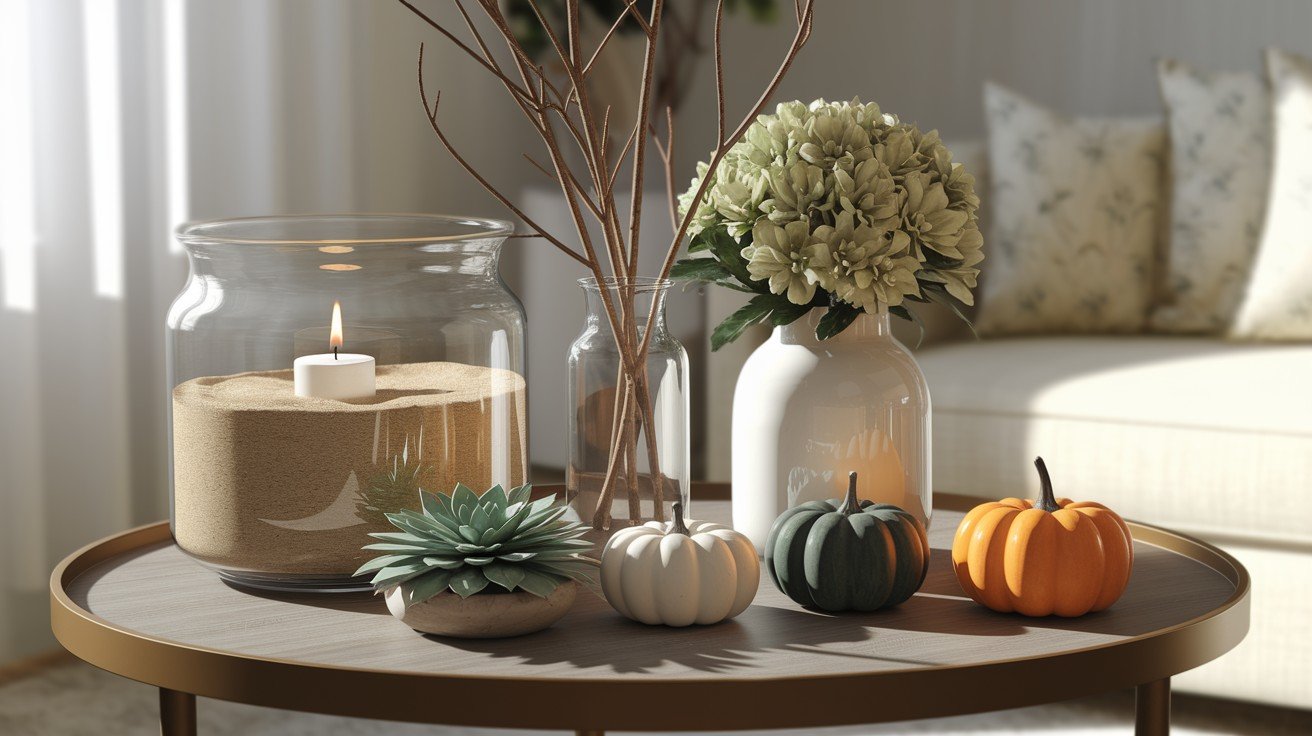
Now that you have placement and focal points figured out, let’s add visual interest. Mixing textures prevents your arrangement from looking flat and boring.
Layering Different Materials
Smooth plus rough equals interesting.
Pair a glossy ceramic vase with a woven rattan tray. Combine sleek glass with rough wood. Mix cool metal with warm fabric. Here’s a winning combination: ceramic vase, wooden tray, linen coasters, and metal candle holder. Each material brings something different to the party.
This isn’t about following rules perfectly. It’s about creating contrast that feels good to look at. Texture mixing makes your arrangement look thoughtful instead of accidental. Like you planned it (even if you didn’t).
Adding Natural Elements for Life
Nothing beats the real thing, but faux plants work too.
Fresh flowers change your whole room’s energy. Even grocery store blooms look great in the right vase. Try seasonal touches: oranges in winter, fresh herbs in spring, mini pumpkins in fall. Keep it simple, though. One type of natural element per arrangement.
Hurricane vases filled with sand and a candle bring coastal vibes anywhere. Succulent arrangements need almost zero care but add life.
Balance is key. If you go tall with branches, keep other elements low.
Smart Functional Considerations
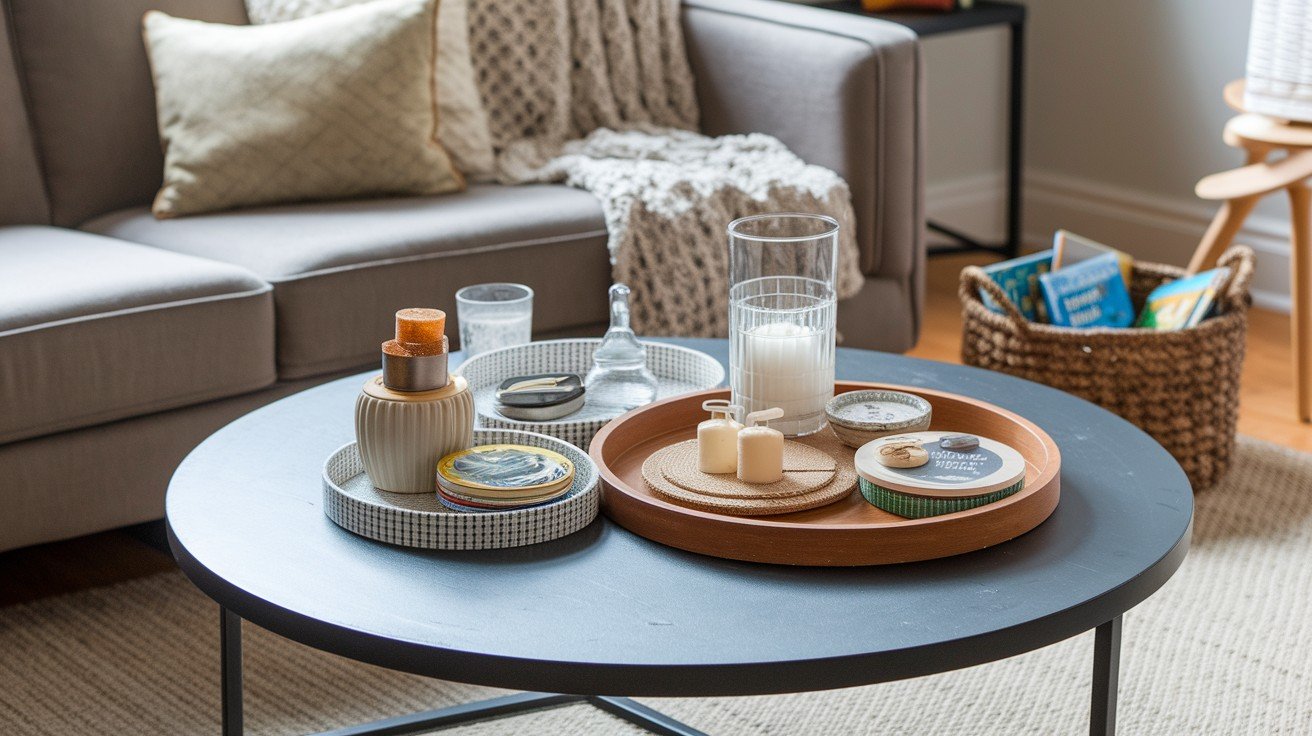
Beautiful styling means nothing if you can’t use your table. Smart design balances gorgeous looks with real-life needs like drinks, snacks, and daily living.
Maintaining Daily Usability
Your coffee table needs to work for real life. Not just Instagram photos.
Leave clear spots for drinks. Keep coasters within easy reach. Make sure people can use the table. Decorative trays are your secret weapon here. They corral small items and make cleanup easier. Plus, you can move the whole arrangement if needed.
Think about traffic flow. If people walk around your table, keep decorations away from the edges. Don’t sacrifice function for beauty. The best arrangements do both.
Household-Specific Adaptations
Kids change everything.
If little hands grab your table, choose lightweight items that won’t break toes. Skip the glass. Use wooden or fabric elements instead. Adult-only spaces can handle delicate pieces. Crystal, fine ceramics, expensive books – go for it.
Family-friendly doesn’t mean ugly. Include a basket with games or books. Choose durable materials that still look good.
Match your styling to how you live. Not how you think you should live.
Essential Tools and Accessories
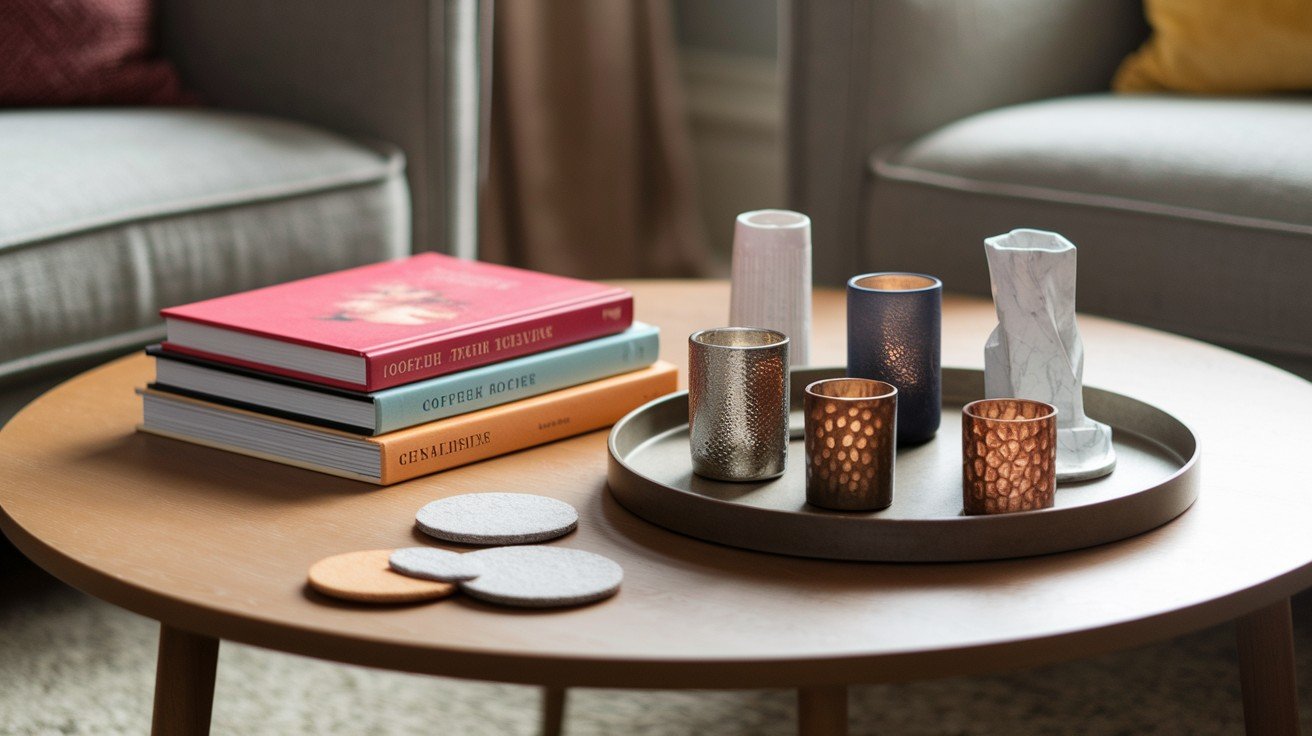
You don’t need to buy everything new to look beautiful. These basic items form the foundation of any great coffee table arrangement and work across different styles.
Foundation Pieces Every Arrangement Needs
Coffee table books are styling gold.
They create height, add color, and give people something to flip through. Choose topics you care about. Decorative trays pull everything together. They create boundaries and make arrangements look intentional.
Keep several candle holders of different heights. Swap them out as needed.
Stylish coasters protect your investment and look good doing it. Choose ones that complement your overall style.
The Professional Editing Process
Start with too much, then take away.
I always gather more items than I’ll use. Then I edit down to what works. Step away for an hour. Come back with fresh eyes. You’ll see what needs to go.
Remove anything that doesn’t add to the story. If an item doesn’t make the arrangement better, it makes it worse. The goal is effortless. Not trying-too-hard.
Trust your instincts. If something feels off, it probably is.
Conclusion
Styling your round coffee table doesn’t have to feel like solving a puzzle anymore. The triangle method is your secret weapon – three groupings that create instant balance every time.
Remember the basics: vary your heights, mix textures, and always leave space for daily life. Your coffee table should look great, but still work for morning coffee and evening snacks.
Start simple. Pick three items you love, arrange them using the triangle rule, and build from there. Don’t overthink it.
The best part? These techniques work whether your style is modern, rustic, or somewhere in between. Your round coffee table can finally become the centerpiece it was meant to be – beautiful, functional, and uniquely yours.
Now go make that coffee table shine. You’ve got this.
Frequently Asked Questions
How many items should I put on a round coffee table?
Follow the triangle method with 3-9 items total, grouped in three sections, leaving space for daily use and visual breathing room.
What’s the best height for coffee table decorations?
Vary heights using stacked books, tall vases, and low candles. Tallest pieces shouldn’t block conversation sight lines across seating areas.
How do I style a small round coffee table?
Use fewer, more impactful pieces. Choose one focal point, add books for height, include a small accent, and maintain functional space.
Should I use a tray on my round coffee table?
Trays help organize smaller items and create defined spaces, but aren’t mandatory. Choose round or organic shapes over rectangular ones.
How often should I change my coffee table decor?
Refresh seasonally or when arrangements feel stale. Rotate accessories, swap books, change flowers, but maintain your core styling foundation.

